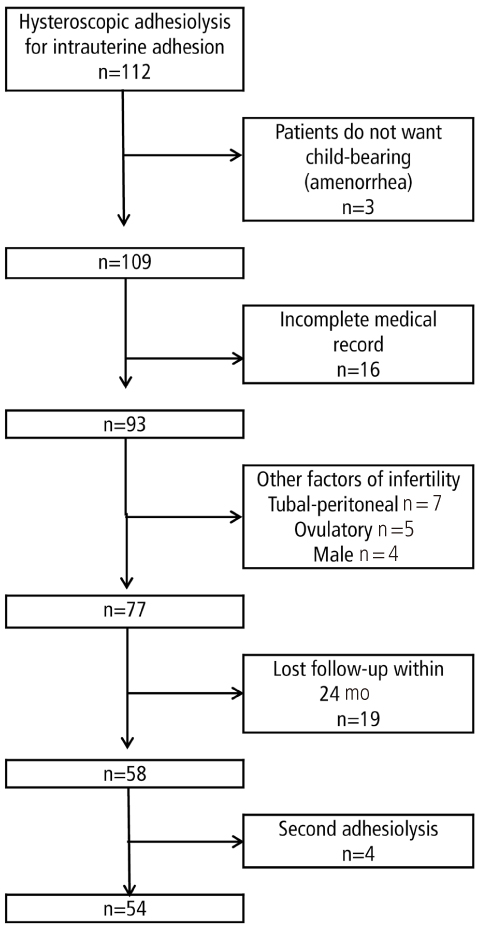Korean J Obstet Gynecol.
2012 Oct;55(10):707-712.
Factors affecting reproductive outcome of hysteroscopic adhesiolysis for intrauterine adhesion: Live-birth rate after surgery
- Affiliations
-
- 1Department of Obstetrics and Gynecology, Eulji University School of Medicine, Seoul, Korea. pwi3110@eulji.ac.kr
Abstract
OBJECTIVE
The purpose of this study is to assess the impact of various factors of hysteroscopic lysis of intrauterine adhesion on live-birth rate after surgery.
METHODS
Medical records of 54 patients suffering from infertility or recurrent spontaneous abortion were retrospectively analyzed. The independent variables were degree of intrauterine adhesion, surgical technique, use of intrauterine Foley catheter, insertion of intrauterine device, and dose of postoperative estradiol. Multivariate analysis as well as univariate analysis was performed.
RESULTS
Among the 54 patients, 17 patients gave live-birth. The degree of intrauterine adhesion was found to be a sole factor affecting the live-birth rate by univariate and multivariate analysis. The mechanical dissection with scissors had been resulted a higher live-birth rate against resectoscopic electrosurgery, but the difference was not statistically significant.
CONCLUSION
The degree of intrauterine adhesion is the most important factor affecting the live-birth. The uses of intrauterine Foley catheter, insertion of intrauterine device and dose of postoperative estradiol have little impact.
MeSH Terms
Figure
Reference
-
1. Fritsch H. Ein Fall von volligem Schwund der Gebormutterhohle nach Auskratzung. Zentralbl Gynaekol. 1894. 18:1337–1342.2. Asherman JG. Amenorrhoea traumatica (atretica). J Obstet Gynaecol Br Emp. 1948. 55:23–30.3. March CM. Intrauterine adhesions. Obstet Gynecol Clin North Am. 1995. 22:491–505.4. Westendorp IC, Ankum WM, Mol BW, Vonk J. Prevalence of Asherman's syndrome after secondary removal of placental remnants or a repeat curettage for incomplete abortion. Hum Reprod. 1998. 13:3347–3350.5. March CM, Israel R. Gestational outcome following hystero-scopic lysis of adhesions. Fertil Steril. 1981. 36:455–459.6. Fernandez H, Al-Najjar F, Chauveaud-Lambling A, Frydman R, Gervaise A. Fertility after treatment of Asherman's syndrome stage 3 and 4. J Minim Invasive Gynecol. 2006. 13:398–402.7. Pabuccu R, Onalan G, Kaya C, Selam B, Ceyhan T, Ornek T, et al. Efficiency and pregnancy outcome of serial intrauterine device-guided hysteroscopic adhesiolysis of intrauterine synechiae. Fertil Steril. 2008. 90:1973–1977.8. Duffy S, Reid PC, Sharp F. In-vivo studies of uterine electrosurgery. Br J Obstet Gynaecol. 1992. 99:579–582.9. Propst AM, Hill JA 3rd. Anatomic factors associated with recurrent pregnancy loss. Semin Reprod Med. 2000. 18:341–350.10. Yu D, Li TC, Xia E, Huang X, Liu Y, Peng X. Factors affecting reproductive outcome of hysteroscopic adhesiolysis for Asherman's syndrome. Fertil Steril. 2008. 89:715–722.11. March CM, Israel R, March AD. Hysteroscopic management of intrauterine adhesions. Am J Obstet Gynecol. 1978. 130:653–657.12. Eum HJ, Choi EY, Cha JM, Chung JY, Park EJ, Kim SH, et al. Clinical analysis of hysteroscopic treatment of intrauterine adhesion. Korean J Obstet Gynecol. 2001. 44:1285–1290.13. Kim BW, Shin SH, Jung S, Hong SW, Kim DH, Kee KS, et al. Clinical outcome of intrauterine adhesion after resectoscopy. Korean J Obstet Gynecol. 1999. 42:2242–2247.14. Thomson AJ, Abbott JA, Kingston A, Lenart M, Vancaillie TG. Fluoroscopically guided synechiolysis for patients with Asherman's syndrome: menstrual and fertility outcomes. Fertil Steril. 2007. 87:405–410.15. Capella-Allouc S, Morsad F, Rongières-Bertrand C, Taylor S, Fernandez H. Hysteroscopic treatment of severe Asherman's syndrome and subsequent fertility. Hum Reprod. 1999. 14:1230–1233.16. The American Fertility Society classifications of adnexal adhesions, distal tubal occlusion, tubal occlusion secondary to tubal ligation, tubal pregnancies, müllerian anomalies and intrauterine adhesions. Fertil Steril. 1988. 49:944–955.17. Thomson AJ, Abbott JA, Deans R, Kingston A, Vancaillie TG. The management of intrauterine synechiae. Curr Opin Obstet Gynecol. 2009. 21:335–341.18. Roy KK, Baruah J, Sharma JB, Kumar S, Kachawa G, Singh N. Reproductive outcome following hysteroscopic adhesiolysis in patients with infertility due to Asherman's syndrome. Arch Gynecol Obstet. 2010. 281:355–361.19. Robinson JK, Colimon LM, Isaacson KB. Postoperative adhesiolysis therapy for intrauterine adhesions (Asherman's syndrome). Fertil Steril. 2008. 90:409–414.20. Orhue AA, Aziken ME, Igbefoh JO. A comparison of two adjunctive treatments for intrauterine adhesions following lysis. Int J Gynaecol Obstet. 2003. 82:49–56.21. March CM. Asherman's syndrome. Semin Reprod Med. 2011. 29:83–94.22. Bosteels J, Weyers S, Puttemans P, Panayotidis C, Van Herendael B, Gomel V, et al. The effectiveness of hysteroscopy in improving pregnancy rates in subfertile women without other gynaecological symptoms: a systematic review. Hum Reprod Update. 2010. 16:1–11.23. Zikopoulos KA, Kolibianakis EM, Platteau P, de Munck L, Tournaye H, Devroey P, et al. Live delivery rates in subfertile women with Asherman's syndrome after hysteroscopic adhesiolysis using the resectoscope or the Versapoint system. Reprod Biomed Online. 2004. 8:720–725.
- Full Text Links
- Actions
-
Cited
- CITED
-
- Close
- Share
- Similar articles
-
- Clinical Analysis of Hysteroscopic Treatment of Intrauterine Adhesion
- Reproductive Outcome of Women with Recurrent Abortions or Infertility Following Treatment by Operative Hysteroscopy for an Intrauterine Septum
- Hysteroscopic management of intrauterine adhesion and their reproductive outcomes
- Extracellular Vesicles Derived from Mesenchymal Stem Cells as Cell-Free Therapy for Intrauterine Adhesion
- A Case of Hysteroscopic Removal of Intrauterine Device with Missing Tail during Early Pregnancy: Successful Ongoing Pregnancy


